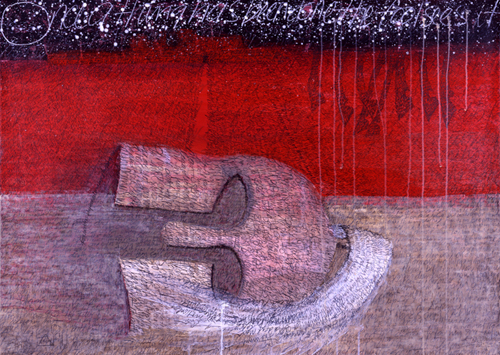| |
“Ilium is a state of mind…”(1)
The Iliad – A New Translation
All
15,693 lines of Homer's Iliad are hand-scribed in this series of works
on paper. Each painting contains an entire book [chapter] based on Richmond
Lattimore's translation. These are not illustrations, nor are they manuscripts, but through attention to the narrative, the handwriting process becomes an integral
part of each piece, echoing the essence of the action.
The art of making physical marks is departing in the 21st century. Not many people write words down physically anymore. The keyboard has taken over the job of scribe. This may be the last time the Iliad will ever be translated by hand. The images are the result of writing while reading. No lines were used to build the images - the words acted as gestural lines. When sentences were grouped together they produced shapes and sometimes lines fell apart to accentuate feelings, which again is personification.
It was built out of itself.
In this 'process' words actively change into simple markings that build up into imagery using layers and forms as authorized by the words themselves.
Nearly three millennia later, this work has been translated into a multitude of languages, changing the content ever so slightly each time.
The Iliad series began in July 2001 and was completed in November 2003.
During its creation, many significant world events unfolded before us
often mirroring the Greek epic, and validating the notion that our unfolding
history is in fact cyclical and that the Iliad is still a contemporary
piece of work.
"The gods in the Iliad represent projections of feelings or activities
of the observed world." (2)
Power, Fear, Hatred, Envy, Compassion,
Honor, Humility, Sleep, and Death are all personified.
While working on this series constant questions arose:
Has mankind changed since this work was created? What have we learned
from our past? Why war?
Is it really over a woman, gold, land, power, or oil? or does humankind simply need a reason to battle?
Is this really about a Greek or Trojan conflict, or is it about a deeply ingrained human condition?
(1-2) Lattimore
This sereis has been exhibited at:
2003 MPG Contemporary, ‘Ilium’ -The Iliad – Another Translation', Boston, MA
2004 Providence City Hall, ‘The Iliad Series/Works on Paper’, Providence, RI
2005 Guilford College, (Solo), ‘Homer’s Iliad- A Visual Translation’, Greensboro, NC
University of Rhode Island, (Solo),'The Iliad - A Visual Translation', Kingston, RI
Iliad Series Exhibition Review- Click here to read the Spotlight Review in Art New England June/July 2006 issue
Iliad Series Exhibition Review- Boston Globe, Dec. 12th, 2003 |
|

